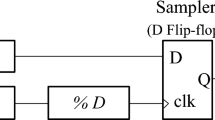Abstract
This paper presents a procedure in designing an oscillator-based hardware random number generator (HRNG) which generates highly random bitstreams even under the deterministic noises. The procedure consists of two parts; HRNG design without considering deterministic noises followed by randomness evaluation under deterministic noises. A stochastic behavior model to efficiently decide the design parameters is proposed, and it is validated by measurement of HRNGs fabricated in 65nm CMOS process. The proposed model directly calculates approximate entropy of output without generating bitstream, which make it easier to explore design space. A simulator considering the power supply noise is also developed for evaluation under deterministic noises.
Access this chapter
Tax calculation will be finalised at checkout
Purchases are for personal use only
Preview
Unable to display preview. Download preview PDF.
Similar content being viewed by others
References
Jun, B., Kocher, P.: The Intel random number generator, cryptography research inc., white paper prepared for Intel corporation (April 1999)
Bucci, M., Germani, L., Luzzi, R., Trifiletti, A., Varanonuovo, M.: A high-speed oscillator-based truly random number source for cryptographic applications on a smart card IC. IEEE Transactions on Computers 52(4) (April 2003)
Balachandran, G.K., Barnett, R.E.: A 440-nA true random number generator for passive RFID tags. IEEE Transactions on Circuits and Systems 55(11) (December 2008)
Petrie, C.S., Connelly, J.A.: Modeling and simulation of oscillator-based random number generators. In: IEEE International Symposium on Circuits and Systems, vol. 4, pp. 324–327 (May 1996)
Petrie, C.S., Connelly, J.A.: A noise-based IC random number generator for applications in cryptography. IEEE Transactions on Circuits and Systems 47(5) (May 2000)
Security requirements for cryptographic modules, FIPS pub. 140-2 (May 2001)
A statistical test suite for the validation of random number generators and pseudorandom number generators for cryptographic applications, NIST, pub. 800-22 (May 2001)
Davies, R.B.: Exclusive OR (XOR) and hardware random number generators, pp. 1–11 (February 2002), http://www.robertnz.net/pdf/xor2.pdf
Marsaglia, G.: Diehard battery of tests of randomness (1995), http://stat.fsu.edu/pub/diehard/
Ergün, S.: Modeling and analysis of chaos-modulated dual oscillator-based random number generators. In: European Signal Processing Conference, pp. 1–5 (August 2008)
Schindler, W.: Stochastical model and its analysis for a physical random number generator. In: Paterson, K.G. (ed.) Cryptography and Coding 2003. LNCS, vol. 2898, pp. 276–289. Springer, Heidelberg (2003)
Tkacik, T.E.: A hardware random number generator. In: Kaliski Jr., B.S., Koç, Ç.K., Paar, C. (eds.) CHES 2002. LNCS, vol. 2523, pp. 875–876. Springer, Heidelberg (2003)
Schellekens, D., Preneel, B., Verbauwhede, I.: FPGA vendor agnostic true random number generator. In: IEEE Proceedings of the International Conference on Field Programmable Logic and Applications, pp. 1–6 (2006)
Ledermann, W.: Handbook of applicable mathematics, vol. 6. John Wiley & Sons, Chichester (1980)
Matsumoto, M., Yasuda, S., Ohba, R., Ikegami, K., Tanamoto, T., Fujita, S.: 1200μm 2 physical random-number generators based on SiN mosfet for secure smart-card application. In: IEEE International Solid-State Circuits Conference, pp. 414–624 (2008)
Sakurai, T., Newton, A.R.: Alpha-power law mosfet model and its applications to cmos inverter delay and other formulas. IEEE Journal of Solid-State Circuits 25(2), 584–594 (1990)
Author information
Authors and Affiliations
Editor information
Editors and Affiliations
Rights and permissions
Copyright information
© 2011 Springer-Verlag Berlin Heidelberg
About this paper
Cite this paper
Amaki, T., Hashimoto, M., Mitsuyama, Y., Onoye, T. (2011). A Design Procedure for Oscillator-Based Hardware Random Number Generator with Stochastic Behavior Modeling. In: Chung, Y., Yung, M. (eds) Information Security Applications. WISA 2010. Lecture Notes in Computer Science, vol 6513. Springer, Berlin, Heidelberg. https://doi.org/10.1007/978-3-642-17955-6_8
Download citation
DOI: https://doi.org/10.1007/978-3-642-17955-6_8
Publisher Name: Springer, Berlin, Heidelberg
Print ISBN: 978-3-642-17954-9
Online ISBN: 978-3-642-17955-6
eBook Packages: Computer ScienceComputer Science (R0)




